Overview
Outsourcing software development presents significant advantages for SaaS owners. It not only enhances cost efficiency but also provides access to a global talent pool and allows for a stronger focus on core business functions. By leveraging external expertise, companies can achieve substantial savings, improved product quality, and a faster time to market.
Industry statistics and expert insights underscore these strategic benefits, highlighting the importance of outsourcing in today’s competitive landscape. Embrace the opportunity to optimize your operations and drive success through strategic outsourcing.
Introduction
Outsourcing software development has emerged as a transformative strategy for SaaS owners aiming to optimize operations and drive growth. By leveraging external expertise, businesses can access a wealth of benefits, from cost savings to enhanced innovation, all while concentrating on their core competencies.
However, this decision prompts critical questions about:
- Quality control
- Communication
- The ability to maintain a competitive edge in a rapidly evolving market
What key advantages make outsourcing an essential consideration for SaaS companies today?
SDA: Tailored Software Development Solutions for SaaS Products
SDA stands at the forefront of tailored application creation solutions, expertly designed for cloud-based services. By prioritizing user-focused design and seamless technology integration, SDA guarantees that each application is not only functional but also strategically aligned with the business objectives of software-as-a-service owners. This customized strategy empowers clients to navigate the complexities of software creation effectively, significantly and driving business growth.
Compelling case studies underscore the effectiveness of this approach. For example, companies that embrace user-centric design have experienced a remarkable 25% increase in customer retention rates, highlighting the concrete advantages of focusing on user needs. As the software-as-a-service landscape continues to evolve, the integration of robust technology solutions becomes imperative for sustaining a competitive edge.
Experts in the field emphasize that a focus on user-centered design not only boosts engagement but also cultivates innovation, making it a fundamental component of successful software-as-a-service development. By collaborating with SDA, software service owners can expect a synergistic process that not only addresses their unique requirements but also exceeds their expectations, ultimately leading to enhanced operational efficiency and accelerated growth.
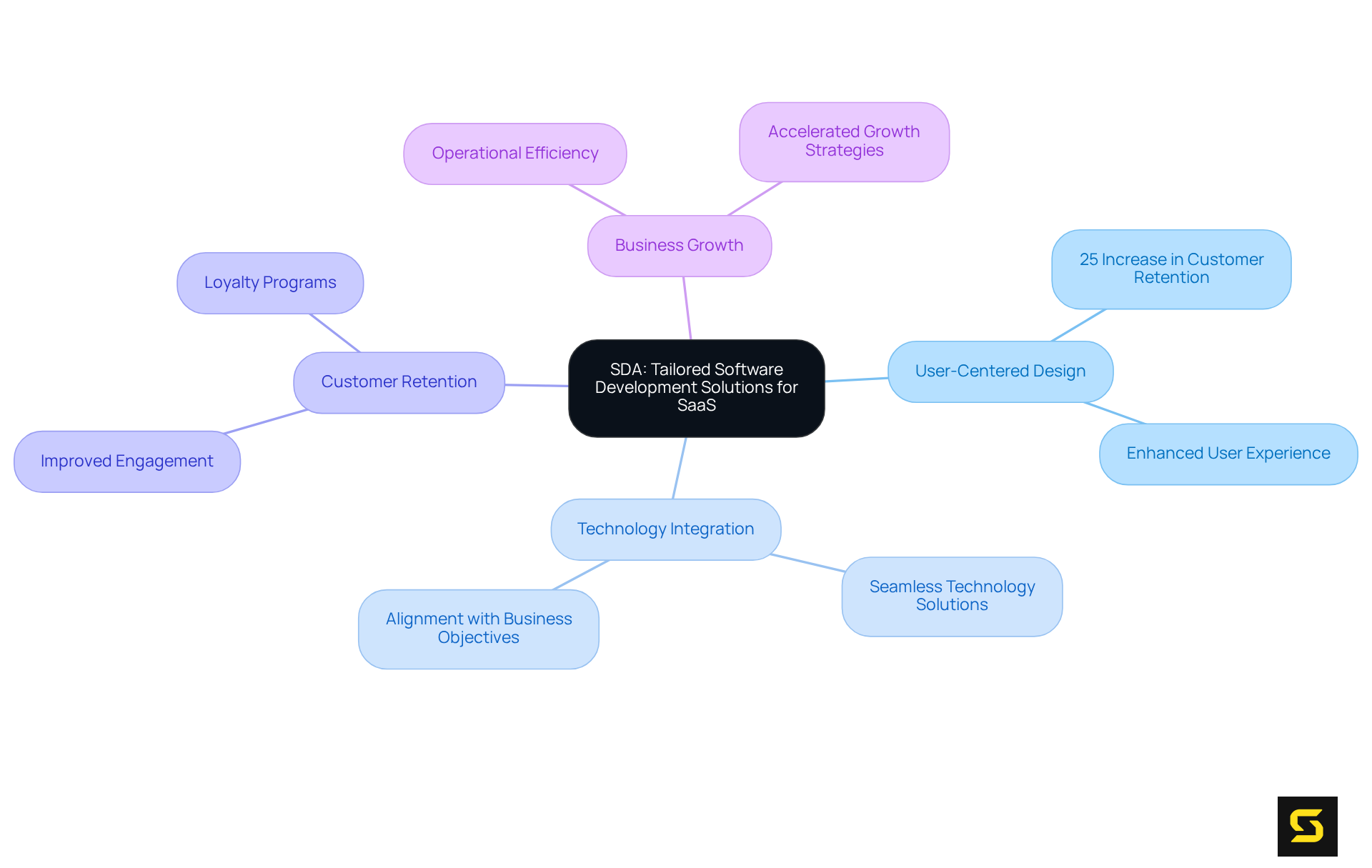
Cost Efficiency: Save Resources by Outsourcing Development
Outsource software development presents a strategic opportunity for platform owners to significantly reduce operational costs. By opting to outsource software development, companies can save on salaries, benefits, and overhead expenses typically associated with maintaining in-house teams. For instance, delegating tasks can lead to savings of up to 70% on software expenses, a substantial advantage that allows companies to allocate resources more efficiently towards critical functions and innovation.
Furthermore, numerous SaaS firms have successfully chosen to outsource software development to streamline their operations. Companies that choose to outsource software development report increased flexibility in scaling their development efforts without the long-term commitments linked to full-time staff. This adaptability is crucial in a rapidly evolving market, where 42% of CTOs recognize that to , they may need to outsource software development.
Expert insights underscore the financial benefits of task delegation, emphasizing that companies can outsource software development to alleviate the burden of hiring and training while gaining access to specialized skills that may not be available internally. Consequently, SaaS companies can concentrate on their core business objectives while ensuring they can outsource software development needs efficiently and cost-effectively. However, it is essential to acknowledge potential challenges, such as communication barriers and the necessity for enhanced project control, which may arise when delegating tasks. Proactively addressing these challenges can further amplify the effectiveness of external service strategies.
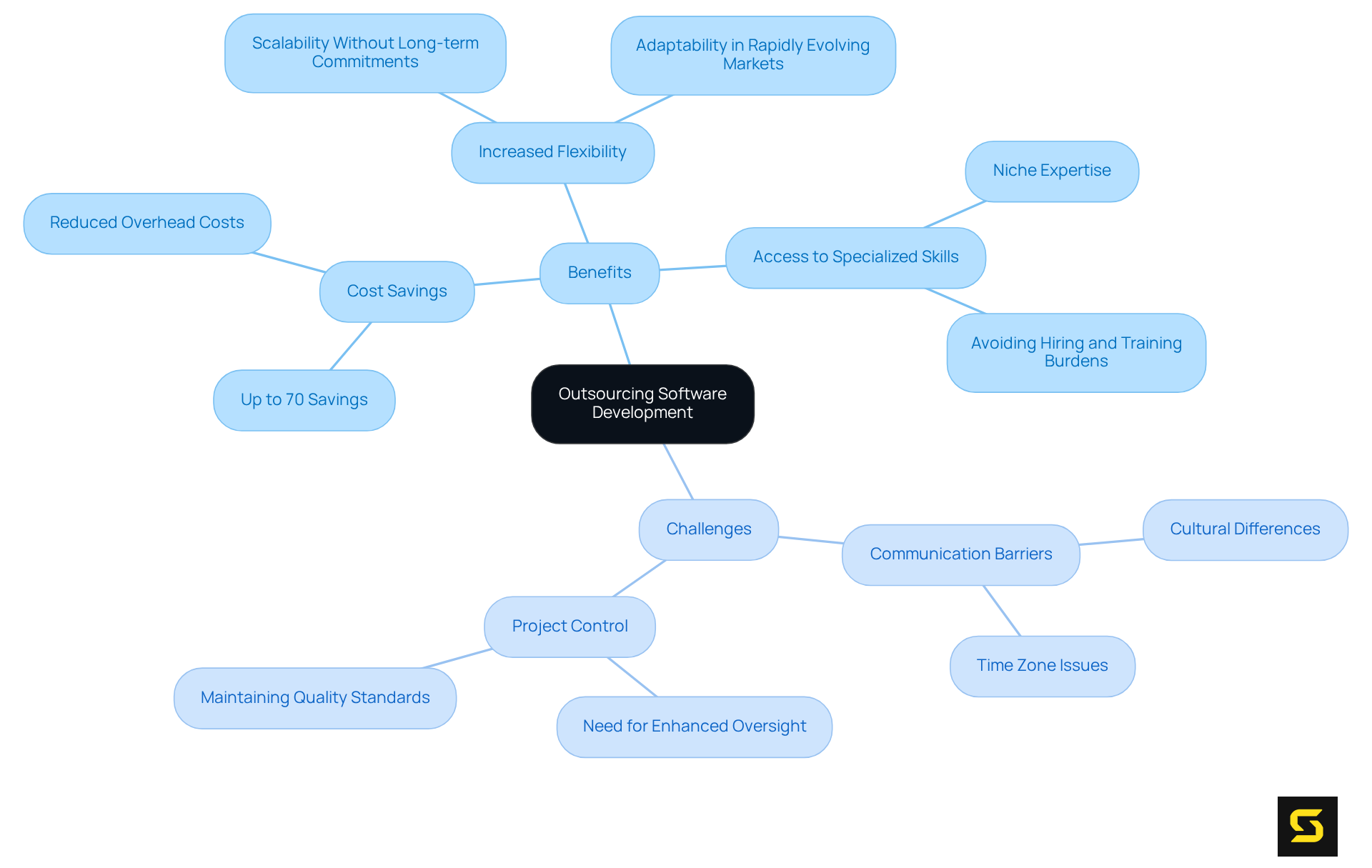
Global Talent Pool: Leverage Expertise from Around the World
By choosing to outsource software development, service providers can tap into a global talent pool, securing skilled experts with diverse knowledge. This strategy not only of the program but also infuses the development process with fresh perspectives and innovative ideas. By choosing to outsource software development and collaborating with international teams, organizations can uncover more creative solutions, ultimately gaining a [competitive edge in the market](https://ttpsc.com/en/blog/software-development-outsourcing-trend-2025-top-insights). Embrace this opportunity to enhance your capabilities and stay ahead in an ever-evolving landscape.
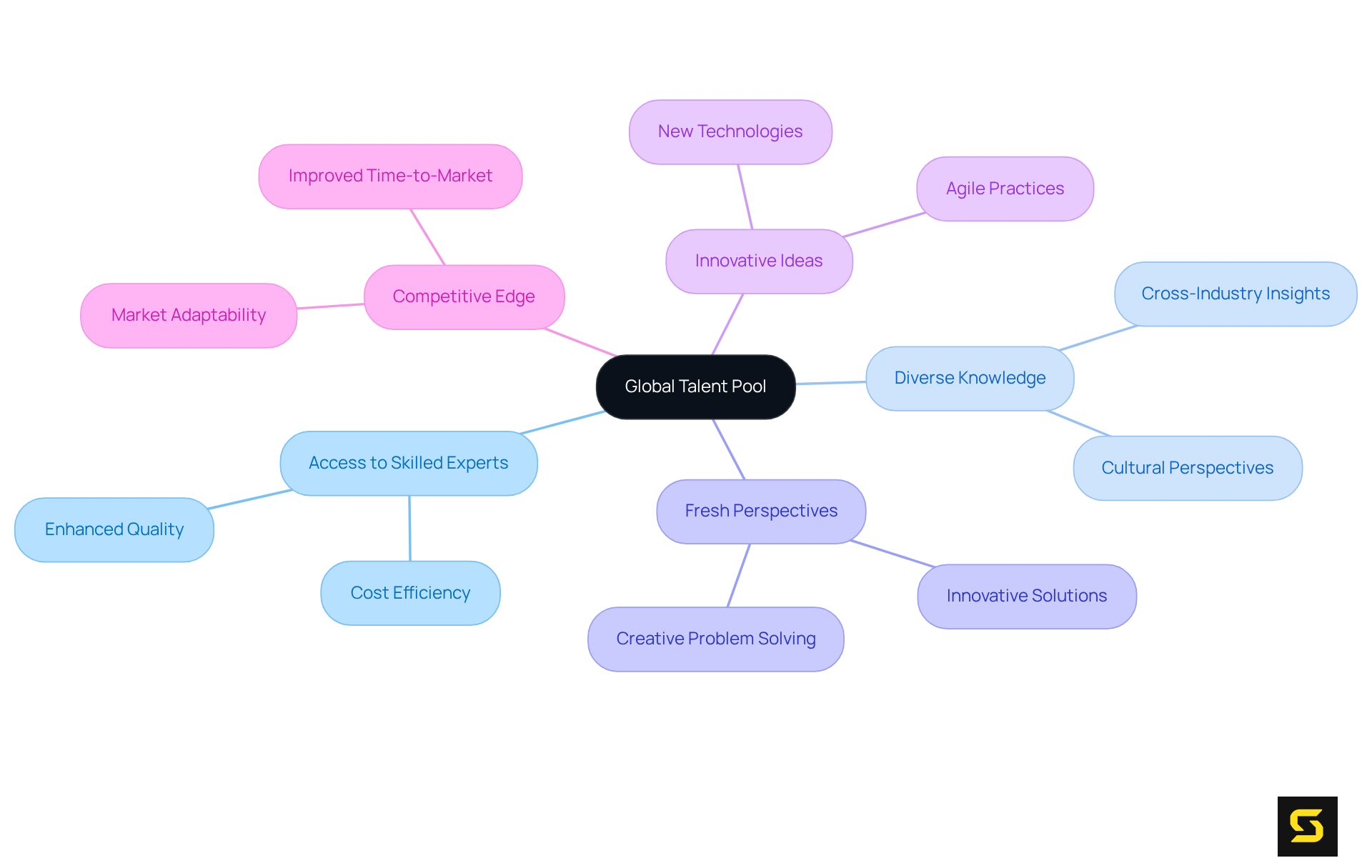
Focus on Core Business: Enhance Strategic Priorities by Outsourcing
By choosing to outsource software development, SaaS owners can empower themselves to concentrate on essential business functions such as marketing, sales, and customer engagement. By deciding to outsource software development to specialized external teams, companies can sharpen their strategic priorities and foster growth without the burden of managing an in-house development team. This approach not only streamlines operations but also .
According to industry insights, around 70% of businesses globally outsource software development and other external services to reduce operational expenses, enabling them to allocate resources more effectively. Business leaders highlight the significance of concentrating on core strengths, with many supporting a strategy that prioritizes what distinguishes a company while opting to outsource software development for non-core tasks. For example, when companies outsource software development tasks, it can lead to enhanced operational efficiency, allowing them to react quickly to market demands and improve customer satisfaction. As Josh Steimle states, "Focus on what you do best and outsource the rest."
By adopting this strategic approach, SaaS owners can ensure that their primary objectives are met while benefiting from the expertise and adaptability that comes when they outsource software development. Additionally, the IT services market is anticipated to attain USD 156.20 billion by 2023, highlighting the growing dependence on external services in the sector. Furthermore, 65% of companies report that when they outsource software development, it enables them to concentrate on their primary business activities, further illustrating the benefits of this approach.
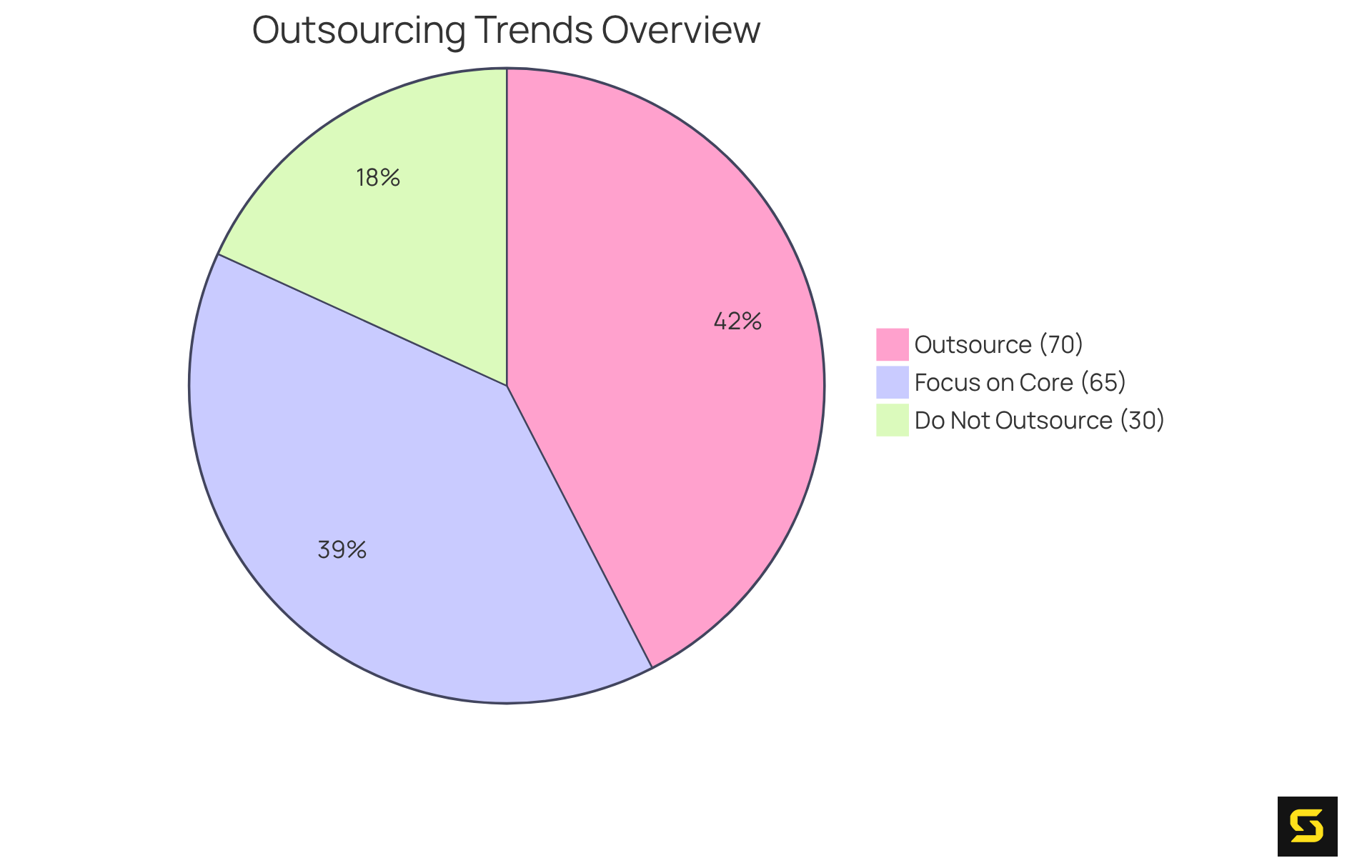
Faster Time to Market: Speed Up Your Development Process
A formidable strategy for significantly reducing the time required to bring a product to market is to outsource software development. By collaborating with dedicated project teams, SaaS owners can optimize workflows, circumvent common pitfalls, and adhere to launch schedules. This agility is crucial in an industry characterized by rapid evolution, where being first can provide a substantial competitive edge.
Indeed, businesses that successfully outsource software development can experience a reduction in product creation time by 30-50%, enabling swift responses to market demands. Furthermore, 64% of IT leaders globally outsource software development, underscoring the trend towards leveraging external expertise.
Industry leaders assert that external sourcing not only accelerates speed but also enhances overall product quality, with 80% of businesses reporting improved software outcomes through external partnerships. As the global IT service market continues to expand, projected to reach $617.69 billion, this trend highlights the increasing reliance on outside expertise to outsource software development, expedite product releases, and maintain a competitive advantage in the software as a service sector.
To fully capitalize on these benefits, software as a service product owners must based on their expertise and historical performance.
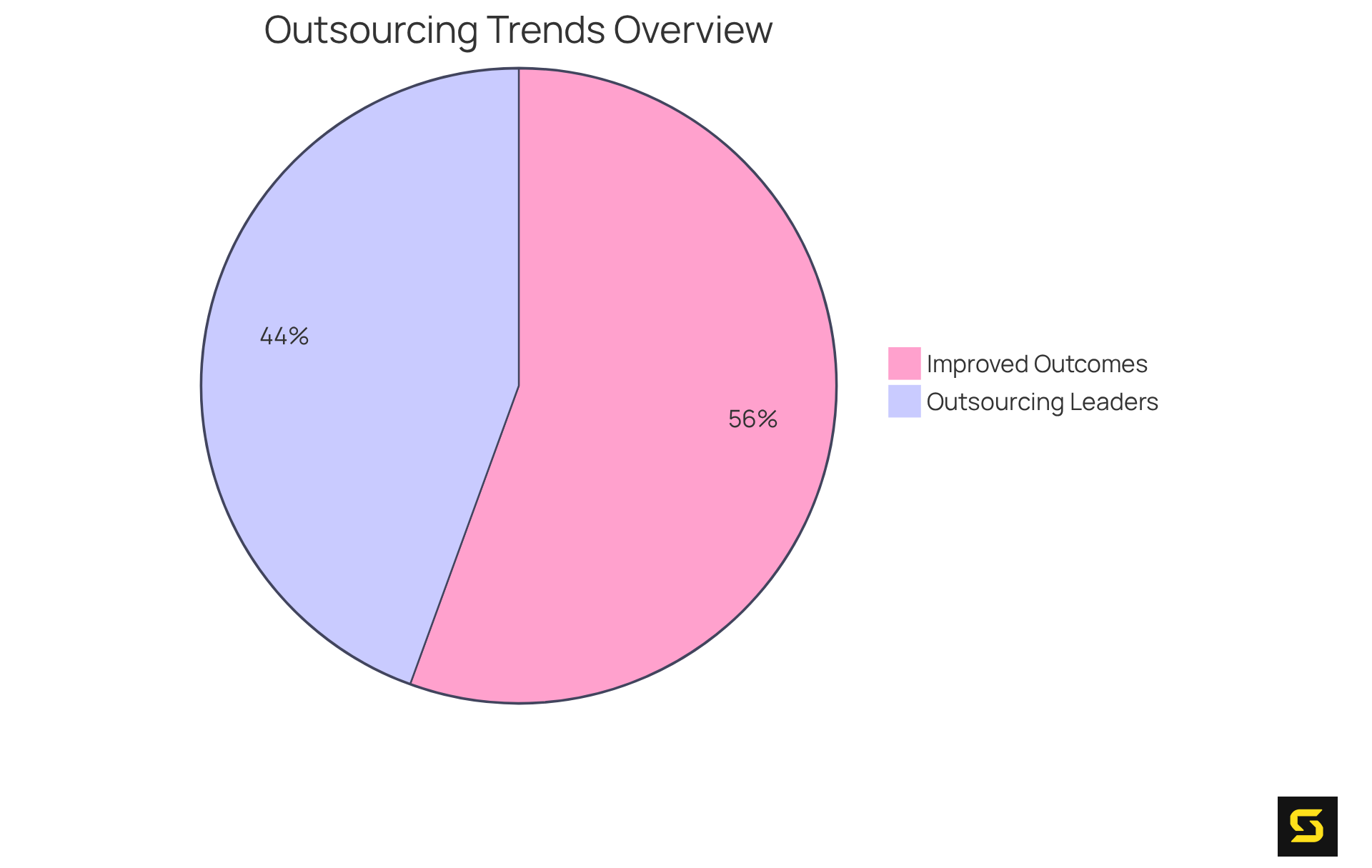
Access to Latest Technologies: Stay Ahead with Innovative Solutions
Outsource software development empowers software-as-a-service owners to leverage cutting-edge technologies and tools, ensuring their products remain at the forefront of innovation. Development partners possess deep insights into industry trends and advancements, enabling software companies to seamlessly adopt new technologies. This strategy not only reduces the need for continuous in-house training but also accelerates the integration of innovative solutions into their offerings.
Numerous successful software-as-a-service firms exemplify this by utilizing external expertise to enhance product features, streamline operations, and elevate user experiences. Consequently, they can swiftly respond to market demands and sustain a competitive edge.
Statistics indicate that 94% of companies employing AI and machine learning rely on firms that outsource software development, underscoring the vital role of external partnerships in driving technological adoption. Furthermore, the global software creation offshoring market is projected to grow at a CAGR of 5.8% from 2025 to 2034, with software creation offshoring revenue expected to rise at a CAGR of 7.54% until 2027. This trend highlights the need for software-as-a-service companies to as a crucial strategy for innovating and thriving in a rapidly evolving digital landscape.
Additionally, 42% of CTOs regard contracting as essential for rapidly scaling operations, while the emergence of hybrid contract models is yielding project outcomes that are 15-20% higher, emphasizing the strategic significance of these partnerships.
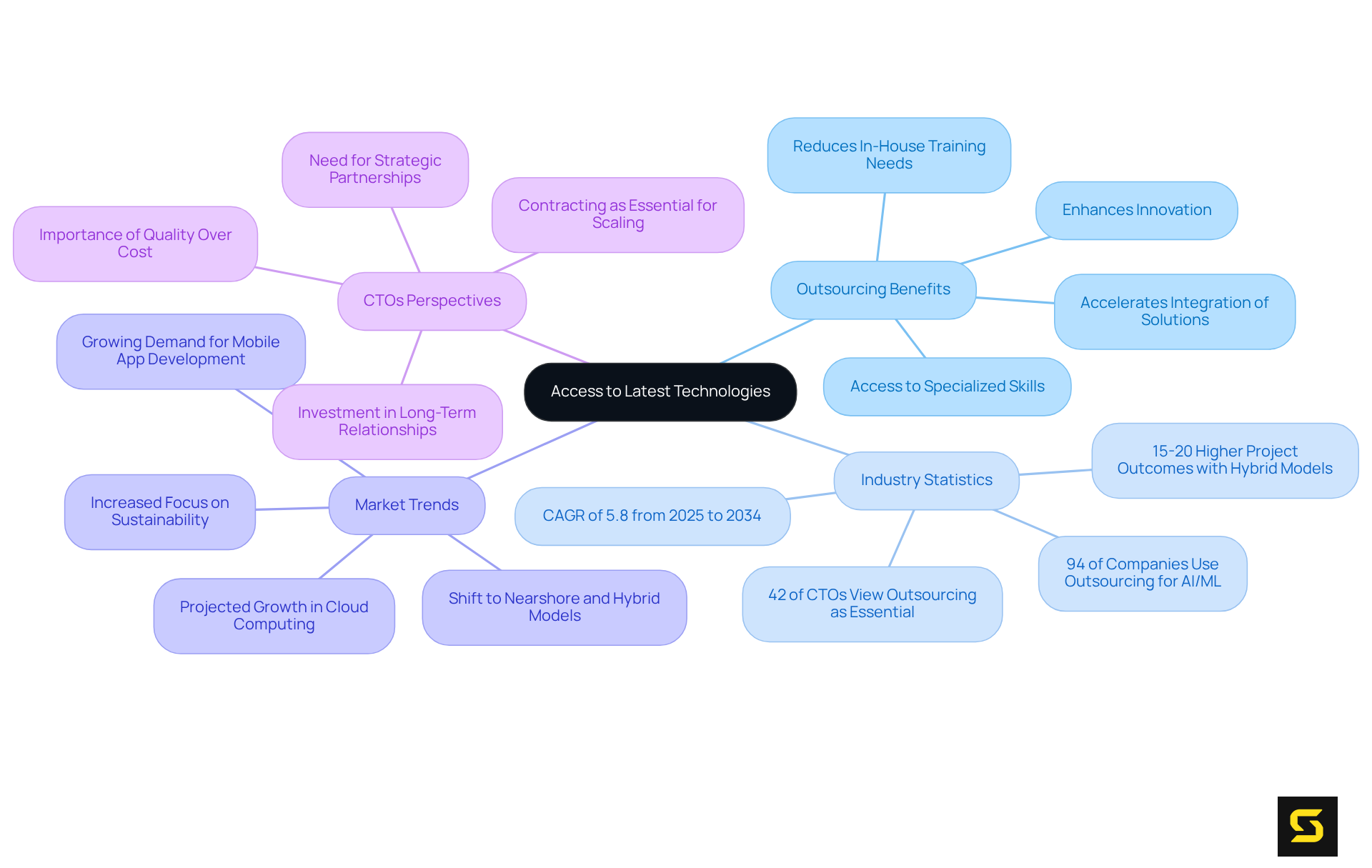
Scalability: Adjust Resources According to Project Needs
Outsourcing empowers SaaS owners to dynamically scale their development resources in alignment with project demands. This adaptability is crucial; projects may require a larger team for a limited duration or a leaner team for ongoing maintenance. By utilizing external resources, companies can modify their assets without the long-term obligations associated with in-house recruitment, enabling a more flexible reaction to evolving project needs. Furthermore, delegating tasks allows companies to scale up or down without long-term commitments impacting their burn rate, offering substantial financial flexibility.
Statistics reveal that 76% of enterprises are currently delegating IT functions, underscoring its prevalence as a strategic approach. This trend highlights the significance of adaptability in resource distribution, allowing companies to enhance their progress efforts based on current requirements.
Business leaders emphasize the importance of this adaptability. For instance, Steve Jobs remarked that time is the most precious resource we have, reinforcing the idea that efficient resource management is vital for success. Additionally, Peter Drucker stated, "Time is the scarcest resource and, unless it is managed, nothing else can be managed," further illustrating the necessity of aligning resources with project timelines to achieve tangible outcomes.
By utilizing external resources, software-as-a-service firms can outsource software development to efficiently modify their capabilities, ensuring they remain competitive and agile in a rapidly changing market. This strategic approach not only but also enables businesses to outsource software development, ultimately driving growth and innovation while maintaining a focus on core activities. However, it is essential to acknowledge potential risks, such as communication overheads and quality issues that can arise in external collaboration. By being aware of these challenges, SaaS companies can better navigate their outsourcing strategies and maximize the benefits.
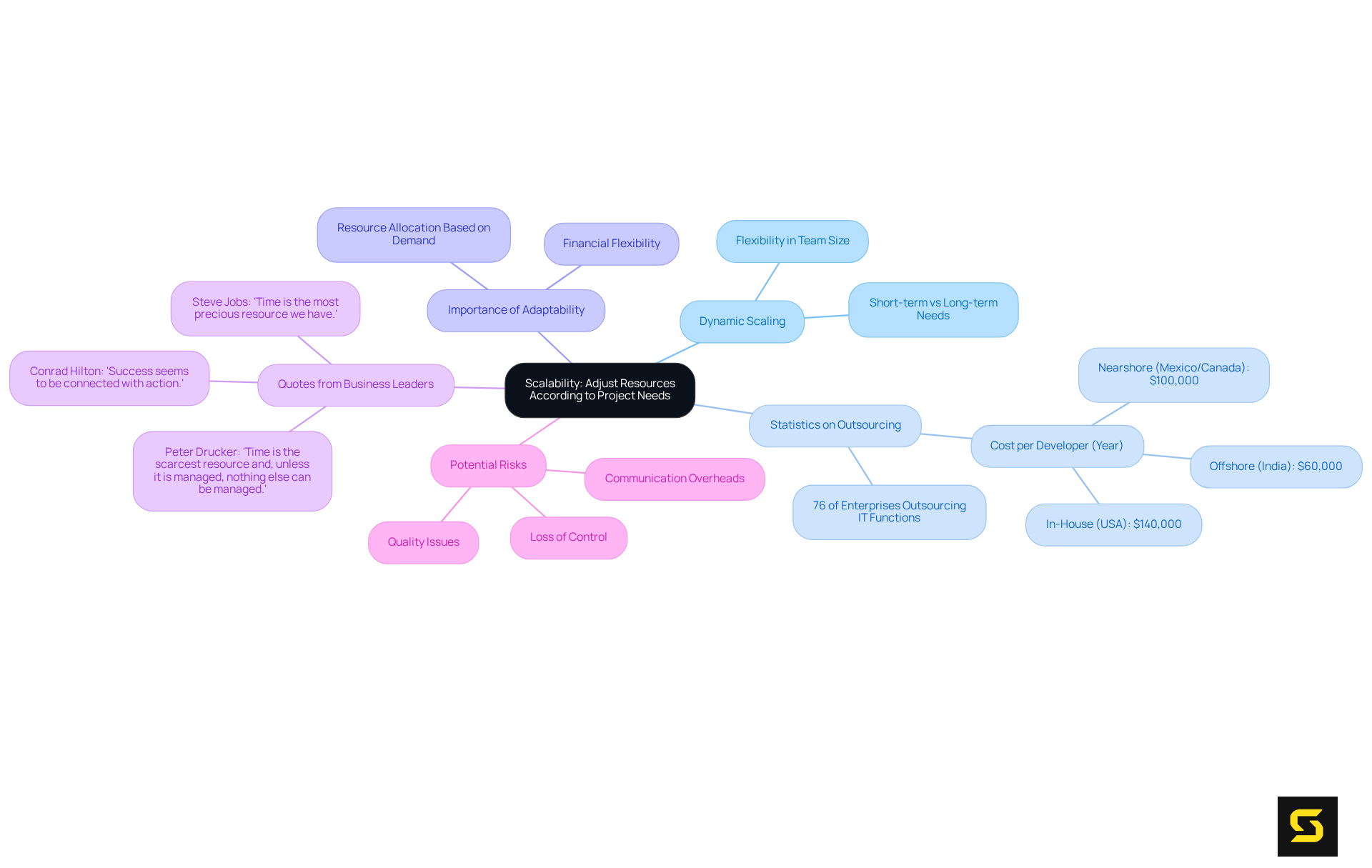
Quality Assurance: Improve Product Standards with Expert Teams
By choosing to outsource software development, companies can access specialized [quality assurance teams](https://sda.company) dedicated to testing and validating products. These expert groups utilize comprehensive testing methodologies, guaranteeing that the final product meets stringent quality standards, functionality, and user experience. This rigorous approach not only enhances customer satisfaction but also builds trust in the product.
For example, a corporate client developed an Employee Wellbeing App that significantly boosted employee engagement and wellness, demonstrating the profound impact of dedicated QA efforts on user experience. Additionally, a microbiology laboratory client benefited from robust authentication technology, which enhanced user experience and security on their website, further illustrating the diverse applications of QA in elevating product standards across various sectors.
Insights from QA specialists highlight that incorporating quality assurance early in the software development life cycle (SDLC) is crucial for quickly identifying and addressing issues. As Erik Fogg, co-founder and Chief Operating Officer at ProdPerfect, asserts, "Testing needs to become a part of the SDLC as early on in the iteration process as possible, not at the end of a feature development cycle." This proactive approach ultimately reduces costs and enhances product reliability.
Organizations that prioritize skilled testing groups, particularly those employing automated testing tools, can achieve greater operational efficiency and maintain a competitive edge in the software-as-a-service landscape. However, it is vital to recognize the importance of manual testing, as it can uncover issues that automated tests might overlook.
By leveraging the expertise of committed QA teams, software companies can elevate their product standards and may choose to outsource software development to ensure they align with the evolving needs of users and market trends. To effectively utilize QA teams, product owners should in their project cycles and balance automated with manual testing strategies.
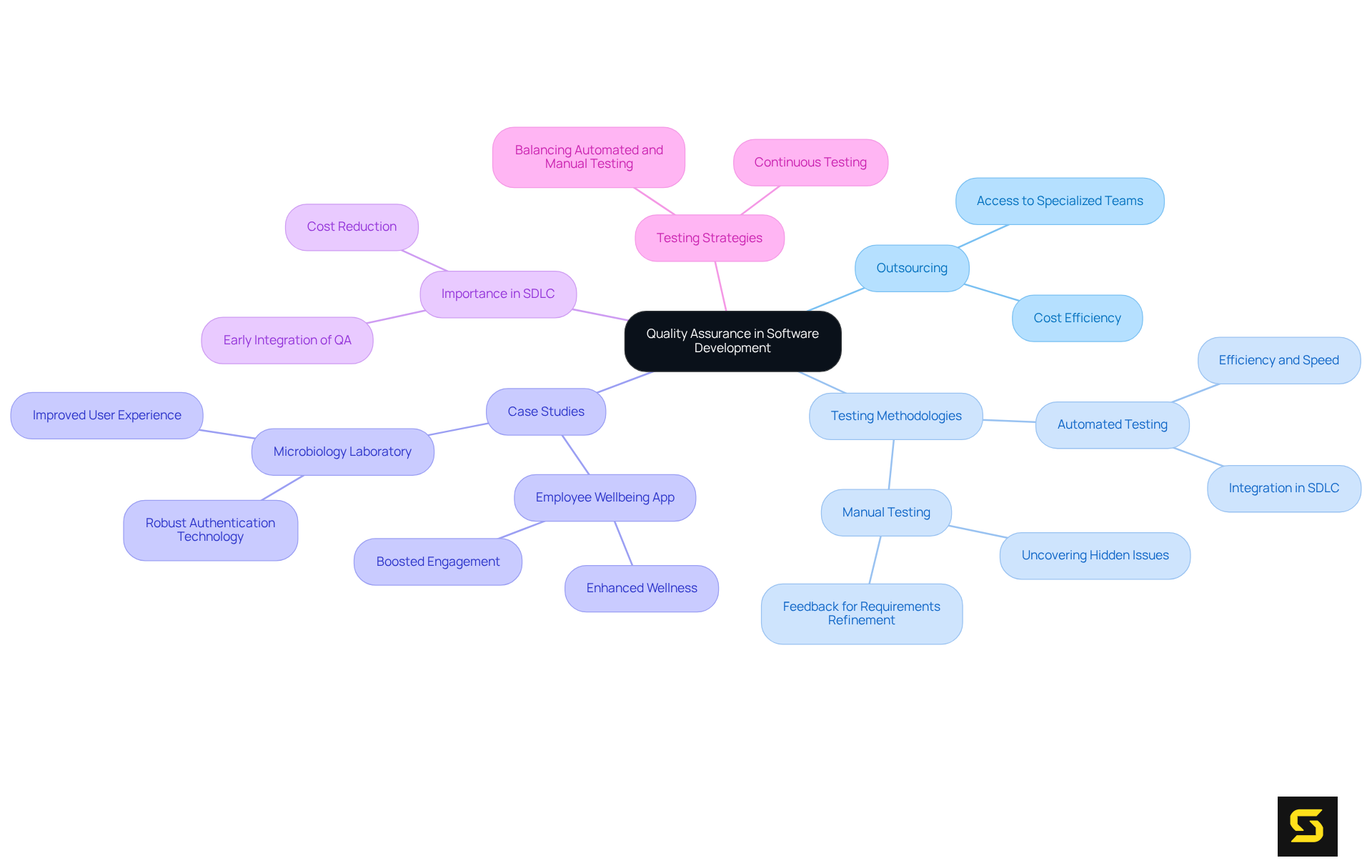
Risk Mitigation: Navigate Development Challenges with Experienced Partners
Partnering with experienced project teams through external resources empowers SaaS owners to adeptly manage the inherent risks associated with software development. These knowledgeable partners bring extensive expertise, allowing them to anticipate potential challenges and implement proactive solutions. Such foresight substantially and failures.
Statistics indicate that organizations leveraging experienced partners witness a 15-20% increase in project success rates, highlighting the immense value of these collaborations. Notably, 65% of businesses are delegating IoT development to acquire specialized skills, underscoring the growing trend of seeking expertise externally.
For example, Syndicode's management of the Fuzu project illustrates how a proficient team can support an expanding user base while addressing complex functionalities, resulting in improved operational efficiency. Furthermore, insights from industry specialists emphasize that maintaining close communication and regular feedback sessions with project teams is crucial for effectively navigating challenges.
As one developer noted, 'You need to make sure the company you choose can work well with your in-house team,' which reinforces the significance of collaboration in successful outsourcing. By choosing to collaborate with seasoned project teams, application owners can significantly enhance their chances of delivering high-quality solutions on time and within budget, while also considering potential risks such as unforeseen expenses and data breaches.
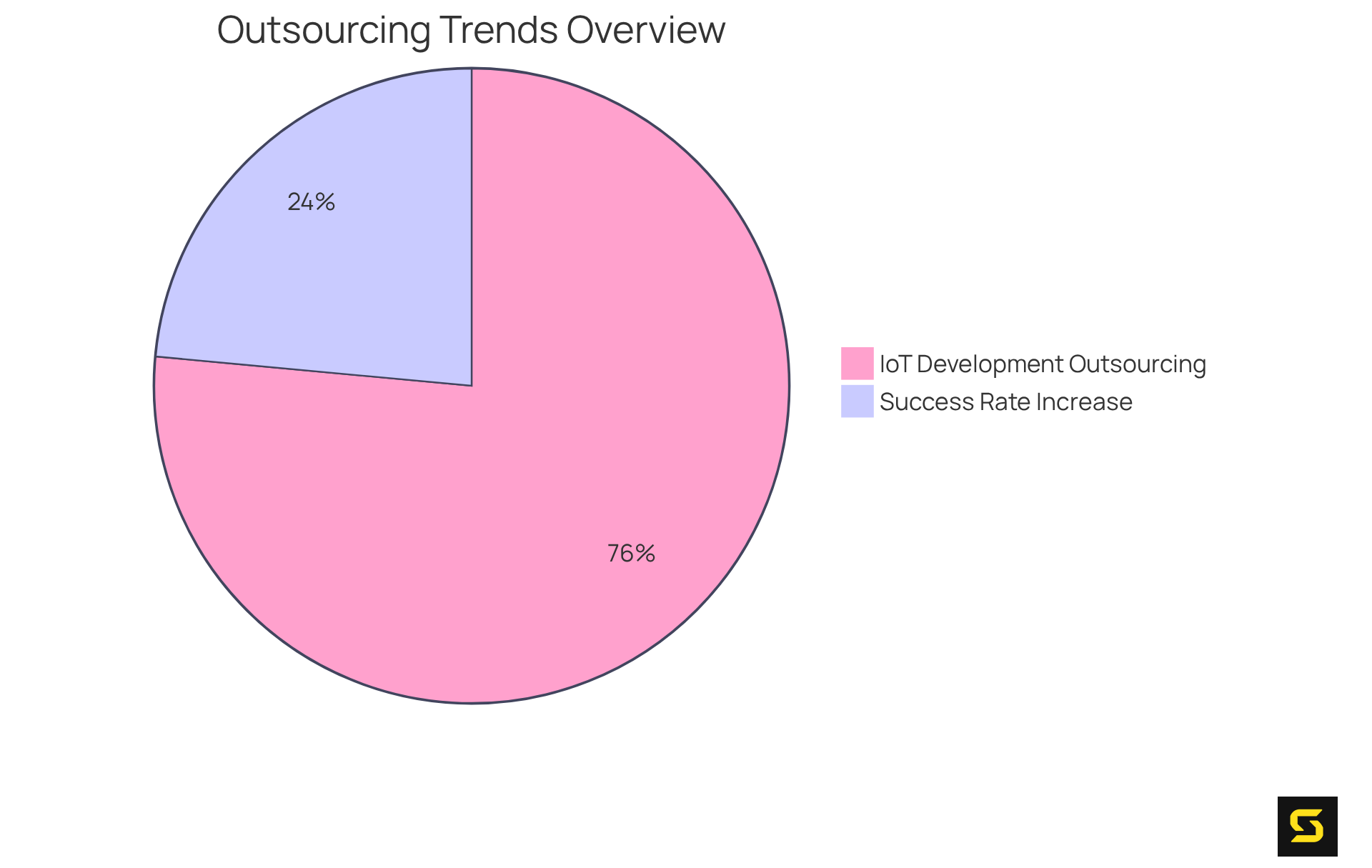
Innovation: Infuse New Ideas into Your SaaS Development Process
Outsource software development is a strategic move that can infuse new concepts and creative methodologies into the software as a service (SaaS) development process. By collaborating with diverse teams, SaaS owners gain access to a wealth of perspectives and innovative solutions. This collaboration not only but also culminates in the development of products that are finely attuned to the evolving needs of users. As such, to innovate, SaaS owners should actively pursue opportunities to outsource software development rather than viewing it as merely an option.
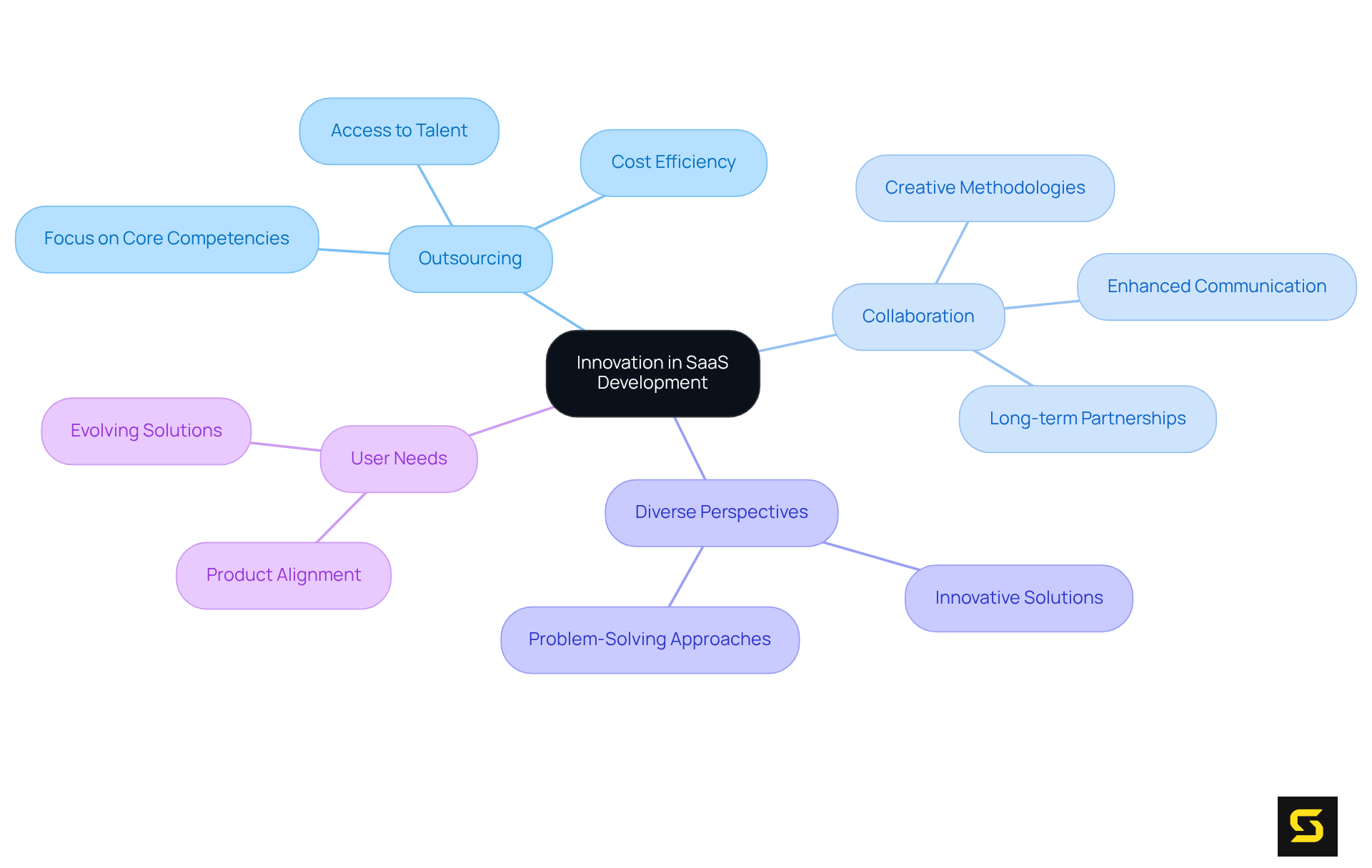
Conclusion
Outsourcing software development offers a transformative opportunity for SaaS owners, empowering them to enhance operational efficiency, leverage global expertise, and concentrate on core business priorities. By harnessing the tailored solutions provided by specialized development partners, SaaS companies can adeptly navigate the complexities of software creation, ensuring their products align with user needs and industry standards.
The key benefits of outsourcing encompass:
- Substantial cost savings
- Access to a diverse talent pool
- Flexibility to scale resources according to project demands
Companies can accelerate their time to market, embrace cutting-edge technologies, and elevate product quality through expert quality assurance teams. Furthermore, outsourcing stimulates innovation by introducing fresh ideas and methodologies into the development process, enabling SaaS providers to maintain a competitive edge in a rapidly evolving landscape.
In an era where agility and adaptability are crucial, the strategic choice to outsource software development can yield significant advantages. SaaS owners are encouraged to adopt this approach, recognizing that collaboration with experienced partners not only mitigates risks but also enhances the overall quality and effectiveness of their software solutions. By prioritizing outsourcing, SaaS companies position themselves for sustained growth and success in the marketplace.
Frequently Asked Questions
What is SDA and what services does it provide?
SDA specializes in tailored software development solutions for cloud-based services, focusing on user-centered design and seamless technology integration to align applications with the business objectives of software-as-a-service owners.
How does user-focused design impact customer retention?
Companies that prioritize user-centric design have seen a 25% increase in customer retention rates, demonstrating the benefits of addressing user needs in software development.
What are the advantages of outsourcing software development?
Outsourcing software development can lead to significant cost savings, with companies potentially saving up to 70% on software expenses, allowing them to allocate resources more efficiently toward critical functions and innovation.
How does outsourcing improve operational flexibility for SaaS companies?
Outsourcing allows SaaS companies to scale their development efforts flexibly without the long-term commitments associated with full-time staff, which is essential in a rapidly evolving market.
What challenges might arise from outsourcing software development?
Potential challenges include communication barriers and the need for enhanced project control, which can affect the effectiveness of the outsourcing strategy.
How does a global talent pool benefit software development?
By outsourcing, service providers can access a global talent pool, bringing in skilled experts with diverse knowledge, which can enhance the quality of the software and introduce innovative ideas.
What should companies consider when outsourcing development tasks?
Companies should proactively address potential challenges such as communication issues and project management to maximize the effectiveness of their outsourcing strategies.





